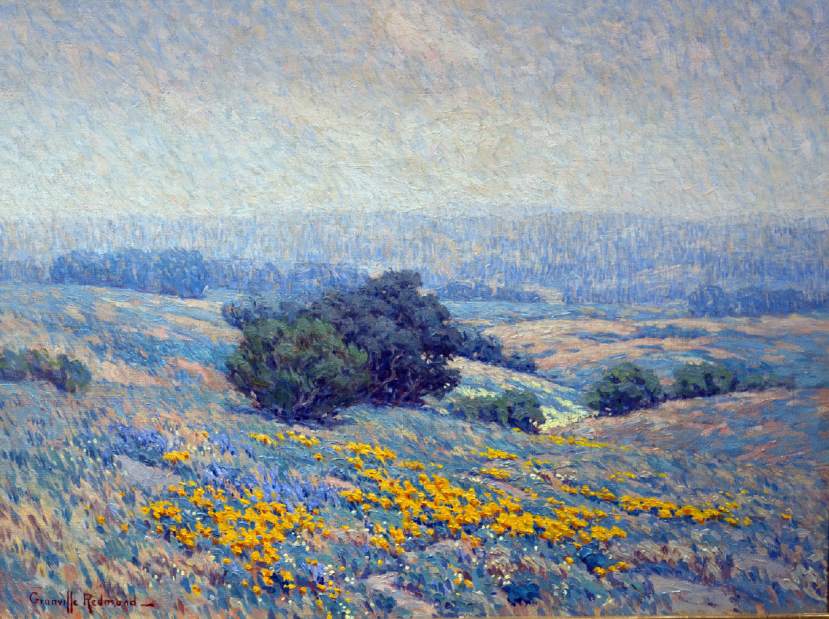https://archive.triblive.com/local/local-news/pennsylvania-museums-begin-divvying-up-bequest-of-dick-scaife-artwork/
Pennsylvania museums begin divvying up bequest of Dick Scaife artwork

Sean Stipp | Trib Total Media
Granville Redmond, 'Wildflowers, Poppies, and Lupines', not dated, oil on canvas from the private collection of the late Richard M. Scaife.
A peculiar mix of tension and excitement filled the upstairs gallery floor of Westmoreland Museum of American Art's temporary location on Route 30 in Unity on Wednesday.
The Greensburg museum's top officials huddled around a table, a single white gallery wall preventing them from peeking at their competition — the executives and trustees of Brandywine River Museum of Art, who flew in from Philadelphia.
The five-hour session marked the beginning of a selection process of more than 500 works Richard M. Scaife decided in his will to split between his two favorite museums.
“We knew that there would be some heartbreaks,” said Westmoreland Museum director Judith O'Toole, “but we knew that we were going to come away with some wonderful things.”
By week's end, each Pennsylvania institution will own half the artworks amassed over a lifetime by Scaife, the billionaire philanthropist and Tribune-Review owner and publisher who died July 4 at 82. It's an enormous bequest expected to thrust the medium-sized Pennsylvania institutions out of their regional niche categories and into the national spotlight.
“It's kind of a game-changer for Westmoreland,” said Sam Berkovitz, a licensed auctioneer and director of Concept Gallery in Regent Square. “It's a very, very big deal.”
O'Toole said she believes Scaife's gift, coupled with a $38 million renovation project, will make her institution “one of the most important museums of American art in the country.”
“When people walk into our galleries, it won't feel like the Westmoreland anymore,” said O'Toole, shortly after joining Brandywine officials in a champagne toast.
The museums divided the 142 most coveted pieces, leaving more than 300 pieces to be distributed over multiple days. The bulk of Scaife's collection includes 19th-century to 20th-century American paintings and drawings by artists including John La Farge, John Kensett, George Inness, Guy Pene du Bois and Martin Johnson Heade.
“We have a few Hudson River painters, but Mr. Scaife's gift takes that to a completely different level,” said Thomas Padon, museum director of the Chadds Ford-based Brandywine.
One by one, museum representatives took turns calling out the names of the artworks they desired most, while Scaife's attorneys and friends Yale Gutnick and Laura Gutnick took notes.
“We cried over this one,” O'Toole said, picking up a small photo of William H. Beard's 1896 oil “Five Bears,” which both museums liked for its illustrative storytelling quality as well as what Padon called “that wonderful 19th-century kind of satirical tradition.”
Westmoreland's first selection was an 1891 oil painting by Inness, “Moonrise, Alexandria Bay,” a large expanse of a moonlit scene executed during the artist's later years while he focused on atmospheric landscapes, O'Toole said.
The event marks a rare form of a bequest designating an “I-pick, you-pick” selection process — but one that pleased officials from each museum because of the dramatic impacts the gifts will make on their collections. Debra Force, president of Debra Force Fine Art and a 35-year professional in the art sector, said the only instance of such a process she has heard of involved spouses who were divorcing.
Scaife had close ties to the Westmoreland museum since its public opening in 1959, and he served on the Brandywine organization's board for 36 years. Separately in his will, he gave $5 million and a set of prized John Kane paintings to Westmoreland and $15 million plus his 900-acre Penguin Court estate in Ligonier to Brandywine's parent organization and conservancy.
Natasha Lindstrom is a staff writer for Trib Total Media. She can be reached at 412-380-8514 or nlindstrom@tribweb.com.
Copyright ©2025— Trib Total Media, LLC (TribLIVE.com)
